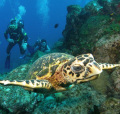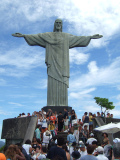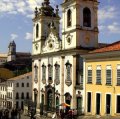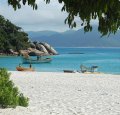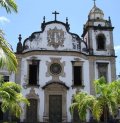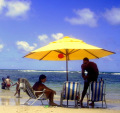Northeast
 Friday, February 5, 2010 at 03:26PM
Friday, February 5, 2010 at 03:26PM The Northeast of Brazil has a spectacular coastline with many of the best beaches in Brazil. It also benefits from a tropical climate and a twelve-month summer. It was also the region where the first Portuguese settlers arrived.
The major cities in the region today were also the biggest cities then. Salvador was first capital city of Brazil, and the cities of Recife, and nearby Olinda, were major commercial centers due to the thriving sugar cane business.
Each of the major cities, and several of the smaller ones in the region, have spectacular examples of colonial architecture with a strong topical feel. Several buildings and areas are considered to be of great cultural and historic importance by organisations such as UNESCO.
Great beaches, amazing weather and cities of great interest are accompanied by areas of outstanding natural beauty, such as the tropical island atoll and nature reserve, Fernando do Noronha, a perfect destination for diving or surfing.
Pearl Travel Guides has already developed Recife Guide and is developing Fortaleza Guide, Salvador Guide and Natal Guide. EAchwill cover the smaller destinations in the region.
São Luís

São Luís is the capital of the stateof Maranhão and is located on the 50km beach of São Luís island in the bay of St Marcus. Uniquely it is the only Brazilian state capital that was founded by the French, and is one of the three Brazilian state capitals located on islands.
The French influence is apparent in some of the older buildings, many of which are in ruins or poor condition due the difficulty in maintaining them in an atmosphere is high humidity, salty sea breezes and a the rainy seasons. A few have been bought by foreign interests or rescued by UNESCO.
The city centre is lively, being the Reggae capital if Brazil and, having small markets, several restaurants, museums and artisan shops. Beach life is also good, with long stretches of sand, popular with Brazilian tourists.
Nearby is Lençóis Maranhenses National Park, famous for its incredible sand dunes, stretching 50km inland from the coast, and 70km along it. From above the dunes look like sheets, hence the name 'lençóis'. Between January and June rain fall fills the spaces between the dunes with pools or lakes of crystal clear fresh water which has an incredible turquoise colour in the sunlight. The pools are best between July and September.
Fortaleza

Fortaleza (Portuguese for Fortress) is the capital city of Ceará state. It has a popular urban beach and is surrounded by many other spectacular beaches. As a popular destination for Brazilian and foreign tourists, the city has a well-established infrastructure and is served by an international airport with good connections to all other areas of Brazil.
The Fortaleza guide will cover the city and all the destinations close by, with details on all the many activities in the area that tourists will appreciate.
Fortaleza is the closest city to one of the most popular remote beaches in Brazil at the moment,Jericoacoara. Itis even top on the list of places to visit for many Brazilians.
Natal

Natal (Portuguese for Christmas) is the capital city of Rio Grande do Norte. It is a region that has invested significantly in developing its tourism infrastructure and the conservation of its natural heritage, including the impressive chain of sand dunes which surround the city, now the Dune State Park.
Natal became the entry gate to the beautiful beaches of the State of Rio Grande do Norte, many of which are still semi-wild, such as Pipa and Pirangi.
The city is also served by an international airport with regular connections to all other parts of Brazil.
Fernando do Noronha

Fernando do Noronha belongs to the state of Pernambuco, the capital of which is Recife. As a destination it is therefore included in Recife Guide
Joao Pessoa

The capital city of Paraiba, Joao Pessoa is a costal capital with some great beaches, a lot of history and several tourist attractions. It is the most eastern point of Brazil and it´s strategic importance was due to it´s location. The small historic centre is well preserved and adds charm and character to a city that is also developing a well organised infrastructure that is attracting foreigners looking to invest in property or buy retirement homes.
The city is generally quite calm, with a small but interesting nightlife and some great restaurants that represent excellent value for money. It is ideally located for those wishing to explore Recife and Olinda (south) or Natal (north), or the many beaches inbetween the two, not to mention one of the very few naturist beaches in Brazil.
The interior hold much history and it´s tourism potential is only just starting to be explored. As a major sugar and cotton growing region in colonial Brazil, it´s history is well worth exploring.
Recife

Recife is the capital city of the state of Pernambuco, first colonized by the Portuguese who established themselves in nearby Olinda soon after arriving in Brazil in 1500. Under Dutch rule (1630-54), the city became one of the most important in Brazil. The natural reefs, the namesake of the city, gave strategic protection and today create natural lagoons at low tide.
The city has rich cultural traditions reflected in musical and cultural traditions, most evident during Carnival and São João. Carnival is most famously celebrated in Recife and Olinda; São João is popular in the countryside and in the interior city of Caruaru.
Recife Guide covers the whole state of Pernambuco, with a focus on the major destinations: Recife, Olinda, Porto de Galinhas and Fernando de Noronha. It also covers other popular destinations in the interior, and all the beaches in the area.
Salvador

Salvador (derived from the historic name, Holy Savior of All Saints' Bay) was the first capital city of Brazil. Today it is the capital city of the state of Bahia. Brazilians call it the capital of happiness due to its easygoing population and numerous festivals and parties, including its street carnival.
The city prospered as a result of the sugar cane industry which resulted in the importation of many African slaves. As a result it is the Brazilian city with the greatest African influence. This is reflected in its distinctive culture, cuisine, music and architecture.
The historical center of Salvador is Pelourinho, recognised as a World Heritage Monument by UNESCO since 1985. This is close to the port area, a gateway to many beautiful beaches.
Salvador Guide will cover the city of Salvador and the major destinations and attractions within the state of Bahia including the small town of Lençois from where the Chapada Diamantina National Park can be explored. The park is an area of mountains and wooded valleys with beautiful waterfalls and caves, such as Poço Encantado, where the rays of sun pierce through a natural window to illuminate the water blue waters. This is an area of astounding natural beauty and some of the best trekking country in South America. see the Salvador Guide
